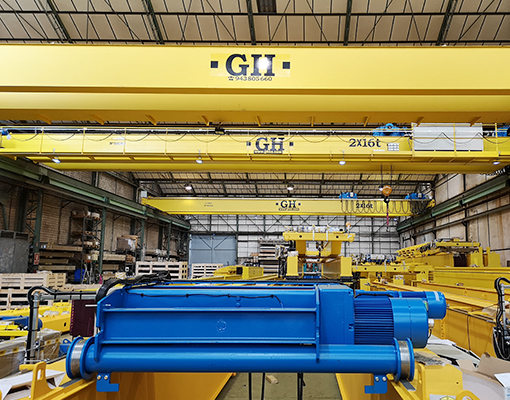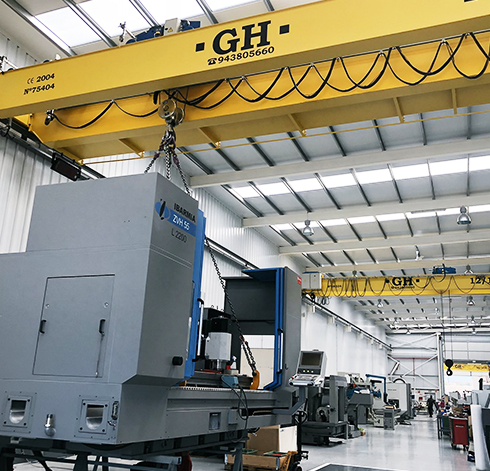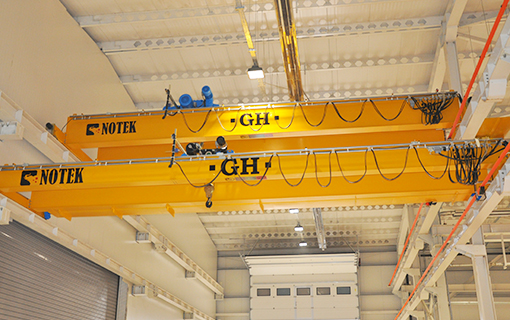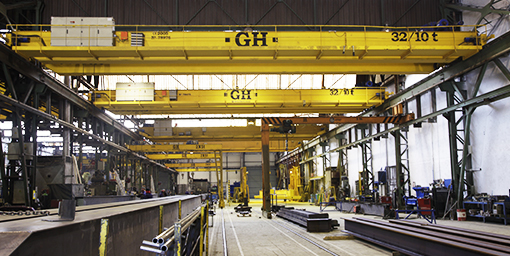Do you need to purchase a double-girder overhead crane? You have a number of things to consider so that you select a crane that delivers what you need. When buying a double-girder overhead crane, you must consider weight capacity, span, hook approach and more. Here are the top things to consider so that you buy the crane that’s right for your application.
Double-Girder Overhead Cranes

First, let’s get on the same page with definitions. A double-girder overhead crane is a type of bridge crane that consists of two or more overhead runways built into the building’s support structure, with two girders (the bridge) running between the runways for the width of the crane bay.
At the ends of each girder are end trucks that move the girders and the hoist forward and backward along the length of the runways as one unit. The trolley and hoist most commonly run along the top of the girder.
Double-girder overhead cranes have a number of advantages over single-girder cranes:
- Greater hook height (the distance above the floor that the hoist can lift). They typically have hook heights that are up to 36 inches higher than single girder cranes
- No limits to maximum span
- No limits to maximum lifting capacity
- Ideal if you need to add service walkways, maintenance platforms, lights, cabs and other accessories
1. Weight Capacity
The first item on your checklist is the amount of weight you will be lifting and moving. Double-girder overhead cranes are designed and engineered for frequent lifting of heavy loads. This typically means loads of 20 tons or more.
If your application requires you to lift and move loads that are lighter than 20 tons, buying a double-girder overhead crane is overkill. You will save time and money by purchasing a single-girder crane instead.
Need to buy a single-girder overhead crane?
2. Span
The next thing to check is the span that your crane will operate in. Cranes over 60′ span typically require double girder cranes or monobox design. Just remember that rolled section girders for cranes over 60′ typically must be spliced and add significantly to the crane weight.
3. Classification
All overhead cranes are classified according to loads and cycles. The classification governs the intensity of the loads and the number of cycles the crane completes during a given period of time.
In the United States, there are six classifications:
- Class A – Infrequent or Standby. Ideal for precise handling at slow speeds.
- Class B – Light Service. Two to five lifts per hour.
- Class C – Moderate Service. Perform 5 to 10 lifts per hour. Loads average 50% of the rated capacity.
- Class D – Heavy Service. Perform 10 to 20 lifts per hour. Not more than 65% of the lifts at the crane’s rated capacity.
- Class E – Severe Service. Perform 20 of more lifts per hour at or near the rated capacity.
- Class F – Continuous Severe Service. Handle loads approaching the crane’s rated capacity and do so continuously, under severe service conditions (high temperatures, dusty environments).
Make sure you buy a double-girder overhead crane that has the correct classification for your application.

4. Hook Height
A top-running, double-girder overhead crane runs on top of each runway beam. An under-running, double-girder overhead crane (commonly known as an underhung crane), runs on the underside of each runway beam.
Top-running cranes have a higher weight capacity than under-running cranes. They also provide more overhead room, and the greatest hook height. If maximum headroom or hook height are important to you, opt for a top-running, double-girder crane.
5. Hook Approach
Also bear in mind that double-girder overhead cranes have a smaller hook approach than single-girder overhead cranes, for both trolley travel and bridge travel, especially on top-running cranes. This has an impact on how you utilize your floorspace beneath the crane. If you are replacing a single-girder overhead crane with a double-girder model, for example, don’t assume that the hook on the double-girder crane will reach as far as the hook on the single-girder crane did—because it won’t.
6. Installation
Double-girder overhead cranes require more material for the bridge beams and runway systems. They also place a greater strain on your building structure and foundation. Your crane may require extra tie-backs or support columns to handle the added deadweight that comes with two girders instead of just one. Factor these things into your total cost of purchase and installation.
7. Manufacturer

The final thing you must consider is the company behind the crane. Does the company simply manufacture cranes, or does it also offer a comprehensive range of other services? Your best option is to select a crane that’s designed, engineered and built by a manufacturer that also offers:
- installations
- engineering support
- custom-manufacturing according to your unique specifications
- a full line of spare parts
- maintenance services
- inspections conducted by certified professionals
- risk assessments to document the condition of your cranes and components
- operator training
Conclusion
As you can see, there are several variables you must consider when choosing the right double-girder overhead crane. At GH Cranes & Components, we offer a wide range of standard and custom double-girder overhead cranes, hoists and crane components. Our products are up and running in heavy manufacturing, automotive assembly lines, ship-building yards, steel foundries and other locations on five continents. If your facility needs an overhead crane for heavy-duty applications, we have a crane for you.
We design and manufacture our cranes and hoists with input from our customers. Their input has resulted in our cranes and hoists offering standard features that improve productivity, increase production, boost efficiency, and enhance safety.


